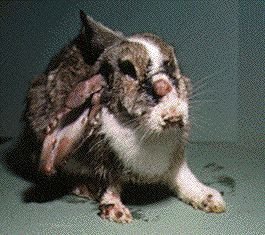CATS
If you have fallen in love with a purring kitten instead, read on. Cats have their own set of viruses which owners should know of too.
FELINE DISTEMPER/PARVOVIRUS
Feline distemper, is caused by a “parvovirus”, hence it is also known as feline parvo. It is a life-threatening disease and the virus is considered ubiquitous, meaning it is present in virtually every place that is not regularly disinfected. The infection is highly contagious among unvaccinated cats, usually kittens and young adult cats living in groups. Barn cats, feral colonies, animal shelter groups, pet stores, and rescue facilities are high risk for outbreaks. Feline distemper does not affect dogs.
The feline distemper virus amounts to a single strand of DNA surrounded by a protein coating. It is extremely stable in the environment, which leads to its characterization as “ubiquitous.” It can last a year indoors at room temperature. It survives freezing as well as treatment with such common disinfectants as alcohol and iodine. Fortunately, a 10 minute soak in bleach will kill it.
Infection occurs when the virus enters the body through the mouth or nose of the victim. Whether illness results or not depends on the immunity present in the victim vs. the number of individual virus particles entering the body.
The feline distemper virus is a “parvovirus.” Many people are familiar with this term as parvovirus infection is a very real concern for dogs, especially puppies. In fact, canine parvovirus is very closely related to the feline panleukopenia virus and much of the information regarding canine parvovirus holds true for feline distemper. The feline distemper virus, however, is more difficult to remove from the environment and more lethal in its victims than its canine counterpart.
An infected cat sheds large amounts of virus in all body secretions including faeces, vomit, urine, saliva, and mucus. The virus persists long after evidence of the original body secretion has faded away. The virus enters the victim’s body and proceeds to infect rapidly dividing cells. The lymph nodes of the throat are first and from there, over the next 2-7 days, the virus rushes to the bone marrow and intestine.
In the bone marrow, the virus suppresses production of the entire white blood cell line, hence the term “panleukopenia” (literally, “all-white-shortage”). The white blood cells are the immune cells that are needed to fight the infection and without them the victim is completely vulnerable to the advance of the virus.
In the intestine, the virus causes ulceration leading to diarrhoea and life-threatening dehydration as well as bacterial infection as the barrier between the body and intestinal bacteria is lost. The patient dies from either dehydration or secondary bacterial infection.
Because most cats are exposed to this virus to some extent, it is unusual for a kitten to have no immunity whatsoever. Further, the vaccine is so effective that even one dose can provide long lasting protection. As a result, infection is largely limited to unvaccinated younger animals kept in groups (which corresponds to exposure to amounts of virus large enough to overwhelm their partial immunity). Mortality of the sick is typically considered 90%, though it has been said that a kitten that survives the first 5 days is likely to survive the infection.
A special syndrome occurs if infection occurs during pregnancy. If infection occurs in mid or early pregnancy, the kittens simply abort. If the kittens are fairly far along, the cerebellum is involved, leading to cerebellar hypoplasia. The cerebellum is the part of one’s central nervous system that coordinates balance and movement, enabling one to walk or run on an uneven surface without consciously thinking about it. Without a normal cerebellum, the kitten is born with marked “intention tremors:” whenever he focuses on purposeful movement, he tremors so much that normal movement is impossible.
Any kitten with fever, appetite loss, diarrhoea, and/or vomiting is a suspect for feline distemper. Classically, a white blood cell count shows almost no white blood cells; there are very few causes of white cell counts this low and the infection can be considered confirmed
If a dead kitten is available for necropsy (“autopsy” in animals is called a “necropsy”), the infection is readily confirmed under the microscope as there are unique tissue findings in feline distemper.
The SNAP Fecal ELISA test kit made for canine parvovirus is often used in cats as a means to reaching a diagnosis. This test detects the presence of parvovirus in stool and is felt to be accurate though the test is not specifically labelled for this use by the manufacturer. Virus isolation, PCR testing, and antibody level measurement are also potential tests for feline distemper.
The infected cat can recover if he/she can be kept alive until his/her immune system recovers from the panleukopenia and can throw off the infection. This means that invading intestinal bacteria must be kept at bay with antibiotics and aggressive fluid therapy must control dehydration. This is essentially the same therapy as for canine parvovirus infection, though the feline experience seems to be more lethal. There is little chance of survival without hospitalization.
If a cat is lucky enough to recover from this infection, generally no permanent damage is retained and the cat goes on with lifetime immunity. The virus is shed for up to 6 weeks after recovery.
There is no way to adequately disinfect the environment; a new cat should simply be vaccinated. Vaccinations after age 12 weeks is generally effective in generating immunity against this infection, though immunity gained from mother’s milk may inactivate the vaccine through age 14-16 weeks. Maintenance boosters are generally given every 1-3 years depending on the protocol of the animal hospital. Vaccinations can be given in a nasal form or in an injection (either modified live or killed virus vaccine) given in the right shoulder area.
[Above info from: http://www.marvistavet.com/html/body_feline_distemper.html]

























